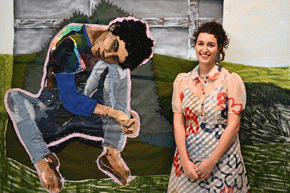Two Wolfgangs and a Robert – all with home talent: a music review by Fraser Beath McEwing
I’m growing to love the Sydney Town Hall as the temporary home of the SSO.

Asher Fisch
Its historic atmosphere and superb acoustics do a lot for the music, never better illustrated than last night when precision and clarity were critical for a convincing Mozart and Schumann.
In traditional style, the concert comprised an overture, moved to a concerto and finished with a symphony. But first there was another in the Fifty Fanfares Commission series, turning out to be something of a lucky dip going on what we’ve heard so far. Nevertheless, I applaud the programmers for giving contemporary Australian composers performance opportunities. On my unofficial ranking, Lyle Chan was an early leader but Lachlan Skipworth is now a contender.
Thirty-nine-year-old Lachlan Skipworth’s piece was unpretentiously named Fanfara – which pretty much described its powerful brass announcements. But they were offset with segues (one employing a solo harp) to introduce more contemplative passages. My companion likened Fanfara to the soundtrack of a yet-to-be-filmed western, but above all found it accessible – even on this first hearing. Skipworth is far from an experimenting amateur. He has quite a body of work behind him, much of which has been very favourably reviewed.

Lachlan Skipworth
Mozart’s The Abduction from the Seraglio hit the ground running when it was first performed in 1782 and its overture also has won permanent hearts. But although the opera attracted big audiences, poor Wolfgang was only paid 100 imperial ducats (around $500 today) as a one-off fee. At 25, he needed a CFO. The brief overture remains an ideal curtain-raiser, encapsulating the vigorous side of Mozart’s style.
If violin concertos are rare, clarinet concertos are rarer, especially those chosen for current concerts. Mozart and Haydn wrote the most popular, although more recent composers such as Carl Nielsen, Aaron Copland, John Adams and John Williams have added to the genre.

Francesco Celato
Mozart’s contribution, Clarinet Concerto in A major, K. 622 is the only one he wrote for the instrument – even though he was reputedly fond of it. He lavished plenty of affection on the slow movement which remains one of the most charming and arresting among all concertos.
Francesco Celata temporarily left his SSO associate principal clarinet’s chair, where he’s been sitting for nigh on 28 years, (he doesn’t look old enough) to take up the role of soloist – having done so on many previous occasions both in Australia and overseas. He is one of many SSO players who could become full-time soloists but opts for a tenured position in the orchestra as well as teaching at the Sydney Conservatorium. One of the challenges of the performance change is to forgo conformity and engage the solo style in terms of volume and rubato. Celata came up trumps on both counts, with pinpoint technique and a reminder that the clarinet is the most versatile of the woodwinds. His slow movement long notes created pools of warm caramel.
The main work in the concert was Schumann’s Symphony No. 2, Op. 61. It is hard to say why this symphony is not more popular – maybe because it is overshadowed by Robert’s famous piano miniatures. The symphony’s four movements go to make up a resoundingly satisfying work. In many places, you could be listening to Beethoven, especially when the tympani get to work with powerful exclamation marks. It is no doddle for the rest of the orchestra, either. In addition to grandly stated themes, there are quite a few staccato gunshots, especially in the first movement. The scherzo second movement rips along at high speed while the third, adagio, swaps the tympani and strings for some romantic wandering among the woodwinds.
The symphony does not reflect the bout of mental illness Schumann was suffering during its writing in 1845. Lyrical and optimistic in character, it never lapses into tragedy.
Schumann’s symphony is a work that demands even more than usual understanding between orchestra and conductor. With 63-year-old, Israeli born, Asher Fisch on the podium, the SSO was in adept hands. Fisch’s conducting was visual as well as musical, as he hopped about and tapped his foot like a dance band leader. He also liked to give one arm a rest while the other did service. If this sounds like a criticism, it is not meant to be. I like animated conductors because they physically live the music and don’t mind sharing it with their audiences.
While Asher Fisch has had considerable experience as a conductor, he set out as a concert pianist – so that his pathway is similar to that of Vladimir Ashkenazy. His most recent post was as principal conductor for the West Australian Symphony Orchestra.
SSO Sydney Town Hall concert 17 March 2021







